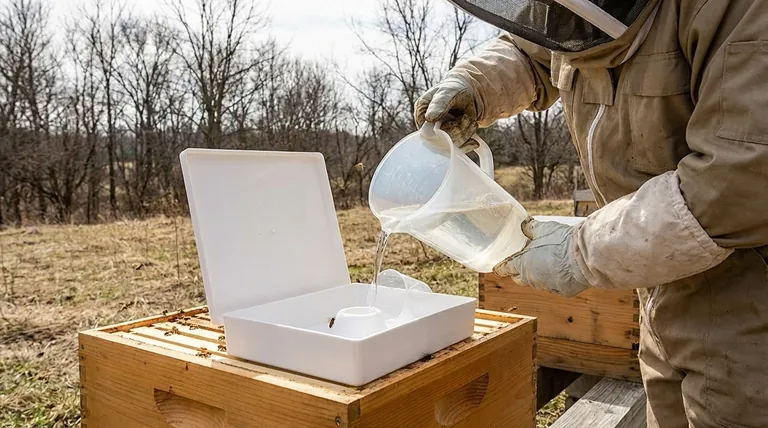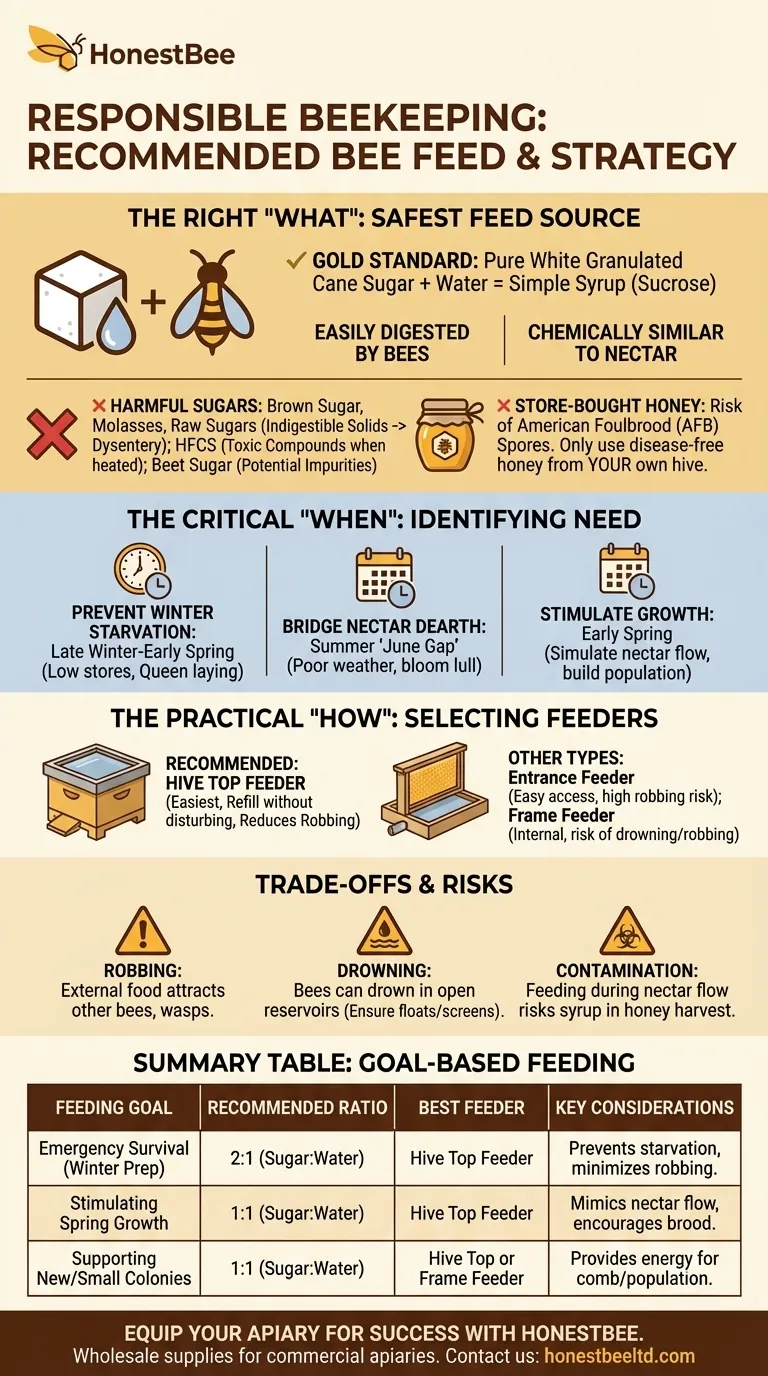For responsible beekeeping, the recommended feed for bees is a simple syrup made from pure white granulated cane sugar and water. This is because its primary component, sucrose, is chemically similar to natural nectar and is easily digested by bees without the harmful impurities found in other sugars.
Feeding your bees is a strategic intervention, not a replacement for their natural foraging. The goal is to provide a focused helping hand during specific periods of need, using the safest possible food source to prevent starvation and support colony health.

The Right "What": Choosing the Safest Bee Feed
The digestive systems of honey bees are sensitive. What seems like a simple sugar to us can be difficult or even toxic for them. The choice of feed is therefore a critical decision for colony health.
The Gold Standard: White Cane Sugar Syrup
Pure white granulated cane sugar is the universally recommended choice. When dissolved in water, it creates a sucrose solution that bees can easily process, very much like the nectar they collect from flowers.
It is free from the impurities, solids, and complex compounds that can harm bees. Typically, this is mixed in a 1:1 ratio (by weight) for spring stimulation or a 2:1 sugar-to-water ratio for fall and winter feeding.
Why Other Sugars Are Harmful
Many other sugar sources should be strictly avoided. These include brown sugar, molasses, and raw sugars, which contain solids that bees cannot digest, leading to dysentery.
High Fructose Corn Syrup (HFCS), while chemically similar, can degrade into toxic compounds, particularly if it becomes heated. Beet sugar, while also sucrose, may contain impurities that are not ideal for bees. The safest principle is to stick with pure cane sugar.
A Note on Using Honey
Feeding bees honey seems natural, but it carries a significant risk. Honey from an unknown source can contain the spores of devastating diseases, most notably American Foulbrood (AFB).
You should only ever feed a colony honey that comes from your own disease-free hives. Never use store-bought honey or honey from another beekeeper, as you could inadvertently wipe out your colony.
The Critical "When": Identifying a Colony in Need
Knowing when to feed is just as important as knowing what to feed. Feeding should be done with a clear purpose, as bees are best served by their own natural forage whenever possible.
Preventing Winter Starvation
The most critical time to feed is from late winter through early spring. During this period, the queen may resume laying, but the colony's winter food stores can run dangerously low before natural nectar sources become available.
Bridging a Nectar Dearth
Sometimes, even in summer, there can be a period of poor weather or a lull between major flower blooms, often called the "June Gap." Providing feed during this time can prevent the colony from consuming all its stores.
Stimulating Colony Growth
Feeding can be used proactively. A light syrup in early spring can simulate a nectar flow, encouraging the queen to lay eggs and build up the colony's population ahead of the main honey flow.
This technique is also essential for helping newly hived swarms or small nucleus colonies, as it provides the energy they need to rapidly draw out comb and establish themselves.
The Practical "How": Selecting the Right Feeder
The delivery method for the sugar syrup also matters, primarily for ease of use, preventing spills, and protecting the colony from outside threats.
Why Top Feeders Are a Recommended Choice
Hive top feeders are widely considered one of the safest and easiest options. They sit directly on top of the uppermost hive box, beneath the outer cover.
These feeders are easy to refill without disturbing the colony significantly and reduce the chance of robbing, where bees from other hives are attracted to the food source and attack the colony.
Common Feeder Types
Other feeder styles exist, such as entrance feeders, which are small jars inverted at the hive entrance, and frame feeders (or division board feeders), which take the place of a frame inside the hive. While functional, they can sometimes encourage robbing or result in drowned bees if not managed carefully.
Understanding the Trade-offs and Risks
While necessary at times, feeding is an artificial intervention that comes with potential downsides that every beekeeper must manage.
The Danger of Encouraging Robbing
Any external food source can act as a beacon for other bees, wasps, and ants. Entrance feeders are particularly notorious for this, as the scent of syrup is broadcast outside the hive, potentially inciting a robbing frenzy that can decimate a weaker colony.
The Risk of Drowning
Bees are not swimmers. Any feeder with a large, open reservoir of syrup poses a drowning risk. Even in recommended top feeders, bees can drown if the model does not include floats or a screened-off area that provides safe access to the syrup.
Dependence and Honey Contamination
Feeding should be ceased as soon as natural nectar is available. If you continue to feed while bees are actively foraging and storing honey, you risk contaminating your honey harvest with sugar syrup. The goal is supplementation, not replacement.
Making the Right Choice for Your Goal
Your feeding strategy should adapt to the colony's specific needs and the time of year.
- If your primary focus is emergency survival: Use a thick 2:1 sugar-to-water syrup in a top feeder to provide dense calories during late winter or fall.
- If your primary focus is stimulating spring growth: Use a lighter 1:1 syrup to mimic natural nectar flow and encourage the queen to begin laying.
- If your primary focus is supporting a new or small colony: Provide a consistent 1:1 syrup via a top or frame feeder to help them build comb and establish their population quickly.
Ultimately, responsible feeding is about observing your bees and providing targeted support only when they truly need it.
Summary Table:
| Feeding Goal | Recommended Syrup Ratio | Best Feeder Type | Key Considerations |
|---|---|---|---|
| Emergency Survival / Winter Prep | 2:1 (Sugar:Water) | Hive Top Feeder | Prevents starvation, minimizes robbing risk. |
| Stimulating Spring Growth | 1:1 (Sugar:Water) | Hive Top Feeder | Mimics nectar flow, encourages brood rearing. |
| Supporting New/Small Colonies | 1:1 (Sugar:Water) | Hive Top or Frame Feeder | Provides energy for comb building and population growth. |
Equip Your Apiary for Success with HONESTBEE
Just as the right feed is critical for bee health, the right equipment is essential for your beekeeping operation's efficiency and profitability. HONESTBEE supplies commercial apiaries and beekeeping equipment distributors with high-quality, durable supplies through our wholesale-focused operations.
We understand the challenges of managing colonies at scale. Our products, from durable hive top feeders to essential hive components, are designed to support the health of your bees and the success of your business.
Let's build a stronger future for beekeeping together.
Contact HONESTBEE today to discuss your wholesale needs and discover how our equipment can support your colonies' health and your bottom line.
Visual Guide

Related Products
- HONESTBEE Professional Hive Top Bee Feeder Feeding Solution
- HONESTBEE Round Hive Top Bee Feeder for Syrup
- HONESTBEE Entrance Bee Feeder Professional Hive Nutrition Solution for Beekeeping
- Rapid Bee Feeder White Plastic 2L Round Top Feeder for 8 or 10-Frame Bee Hives
- Classic Boardman Entrance Bee Feeder Hive Front Feeding Solution
People Also Ask
- How do I keep bees from drowning in my top feeder? Ensure Safe Feeding for Your Hive
- How is the plywood floor fitted into the hive-top feeder? Ensure Longevity with a Floating Floor Design
- Do I need an inner cover with a hive top feeder? Optimize Your Hive Setup for Healthy Bees
- What safety features are included in top feeders? A Guide to Drowning Prevention and Hive Safety
- What features make top feeders a reliable choice for beekeepers? A Guide to Safe, Efficient Hive Nutrition



















